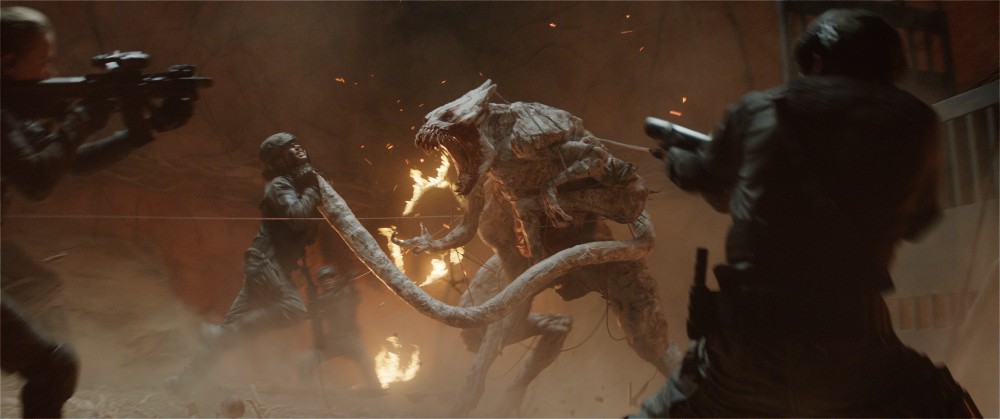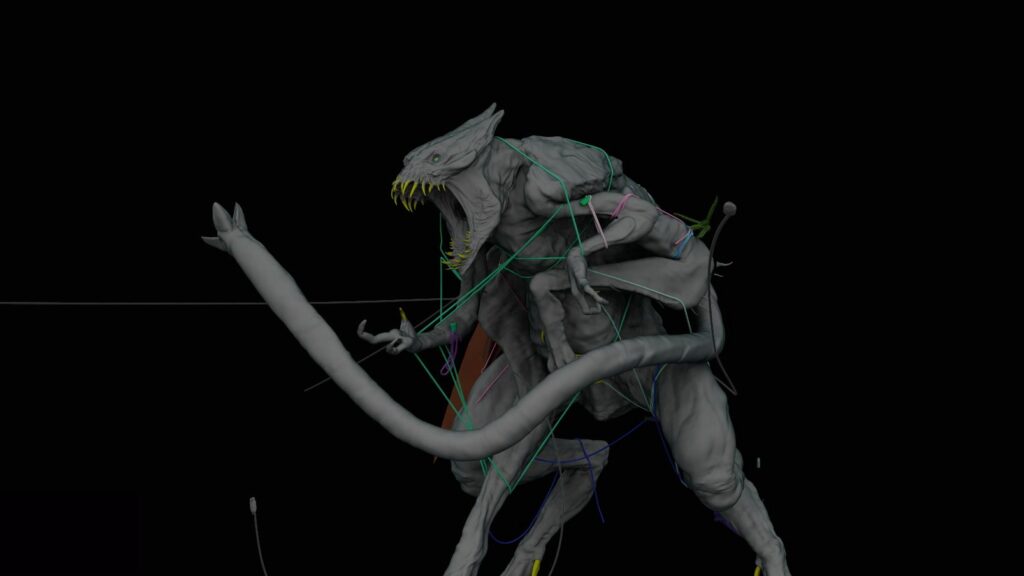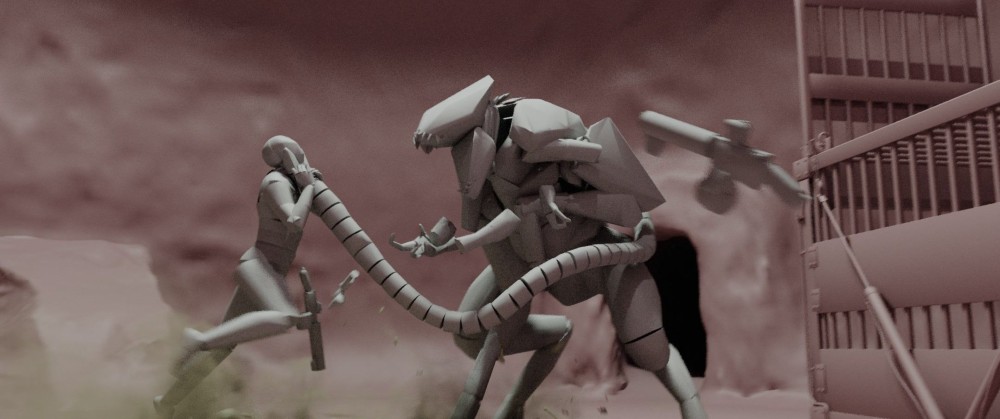
There’s a lot of amazing crafts on display in Chris McKay’s sci-fi action flick, The Tomorrow War, starring Chris Pratt, but clearly, the visual FX used to create the amazing alien creatures is at the top of the list. It may come as no surprise that a lot of the creation of the “Whitespikes” (as they’re called) and particularly the ferocious female Whitespike, was the work of New Zealand’s Weta Digital.
Weta also created a lot of the environments including “Deepswell” an enormous oil refinery that’s converted into the base for the film’s heroes, leading to an amazing action set-piece where it gets absolutely swarmed by Whitespikes.
VFX Supervisor Sheldon Stopsack has been at Weta Digital for roughly six years, working on films like Terminator Genisys, Gemini Man, and the Oscar-winning Roma. Before that, he was a CG Supervisor at MPC, working on blockbusters like Guardians of the Galaxy, Harry Potter and the Deathly Hallows, and many more.
Tomorrow War Animation Supervisor, Carmelo Leggiero, has been working at Weta going back to Peter Jackson’s The Hobbit movies with a specialty in bears, apparently, having animated the giant bear Beorn in The Hobbit: The Battle of the Five Armies, as well as bears in Jon Favreau’s The Jungle Book and Dawn of the Planet of the Apes. His zombie polar bear for Game of Thrones Season 7 helped Weta Digital win a Primetime Emmy. Most recently, Leggiero was Lead Animator on Birds of Prey, which created Harley Quinn’s pet hyena, Bruce, and he performed similar duties for Dwayne Johnson’s pet jaguar, Proxima, in the upcoming Jungle Cruise.
Below the Line spoke with Stopsack and Leggiero a few weeks back about their work on The Tomorrow War, which ended up being delayed due to Covid as Weta and the rest of the post team had to finish up the movie during the pandemic.

Below the Line: Lots of good news this week as The Tomorrow War did well enough on Amazon they’re developing a sequel, and Sheldon, you were just invited into the Academy of Motion Picture Arts and Sciences, so congratulations on both those things!
Sheldon Stopsack: It was a good week, that’s for sure. It’s obviously nice to see that the Tomorrow War is now finally out. It’s obviously been sort of delayed for various reasons that we all know about, so it’s exciting to really be in a position where the wider audience gets to see it. And it’s also nice to see that it’s actually doing reasonably well on the streaming platform, so the numbers are sort of simply speaking for themselves.
BTL: How long ago did you guys get involved, and how were you brought on to doing The Tomorrow War?
Stopsack: I might take this one and give you a bit of history there. We got involved fairly early on, myself and Carmelo — that was during the pre-production phase. It was at a time where creature design had been somewhat kicked off, and there was a fair amount of concept work that had been done. I think in parts, it was fine with production and the filmmakers had a production designer, while creature design sort of kicked off with various freelancers. But then also, I think the Weta art department, even before I joined, was sort of involved in the process of developing. There was a little bit of a foundation laid out, I suppose, and there was some design work that was very much liked. Like I said, the pre-production phase was sort of kicking about — no photography obviously took place at that time — and it was really for us to gauge at that point [how] to take this to the next level. I think a number of houses or shops were sort of eyeing the idea of being involved on the show. We sort of had a bit of engagement with Jamie [James E. Price, overall VFX Supervisor] and Chris initially, really to see what we could potentially bring to the table to take the creature to the next level and bring it to life. That sort of resulted in us doing a little bit of pitch work, but it was really more of a design opportunity, 2.0, I suppose really, to explore a little what this creature is all about, what can we bring to the table? And how can we think of it in a slightly different way?
So we kicked off with a small group of artists from all the different departments here, and Carmelo was obviously part of that really to push things along. We tried to keep it as a very agile workflow to not necessarily make this a production-ready asset just yet or anything. It was just more of a small group that was set up to design and explore the opportunities that we may not have thought about in the world of this creature. What is it that we can do new, how can we discover the creature? Concept is always one thing, but once you start seeing moving, you start asking yourself questions about what is their characteristic? Are they intelligent? What characteristics do they bring in terms of do they act like a pack of wolves? What is it that makes the creature unique?
It was a great process, because it was sort of encouraged for everyone in this small group to just chime in and bring ideas to the table — nothing really was forbidden, as crazy as the idea may be. It was basically like an open forum. We wanted to really explore the whole spectrum, so that we don’t miss out on any opportunities or things that we may not have thought about. It was pretty well received, and it was an interesting process because it kicked off really well and people really grew incredibly fast-paced. It was a process that really opened up a lot of possibilities and ideas for us internally as well as obviously than for the filmmakers.
Carmelo Leggiero: Yeah, absolutely, and then the fact that we were involved so early, even though we had a bit of the design already in place, we were able to, through motion, tweak things here and there, like the length of the legs, and the neck, just to make it more efficient and making sure that the creature would move properly, throughout, doing any type of things that we thought they could do. And they could do a lot. They could walk on two legs, they could swim, fly, run, they could do everything. So it was a really, really challenging creature, and it gave us a lot of freedom to experiment, from the VFX team, client-side, they were open to anything. That was really, really cool.
Stopsack: In hindsight, kind of retrospective as well, what’s interesting is to see [is that] some of the early studies that we’d done actually ended up being one way or another on the movie. There were a lot of inspirations of things that we explored that ultimately were so well received and sort of captured really the essence of the creature that we were like, “Let’s make a shot that shows us the creature like that.” It really sort of all led to the final result in one way or another.
BTL: Had they already created a maquette or some sort of 3-dimensional version of the creature?
Stopsack: There was obviously the 2D artwork [designed by Creature Designer Ken Barthelmey], which was the most advanced. There were art models that were kicking about, but as Carmelo said, I think part of it, as much as we thought of it as a sort of creative design process, we also obviously had the mechanicals to consider. So we looked at limb length and the tentacles and all of this was sort of like, “What is the tentacle? Is it its own little character? Does it have its own intelligence?” But all of that needed to equate into something that became obviously also functional for us, so that we can utilize it in a way. Part of the advanced design was a little bit to define the character, define its characteristic, define its movements, and the sense of like, “How do we want to set it in a scene? And how do we want to coordinate? How do they communicate?” Communication is a good example, for instance, where we sort of had this chatter idea, and the chatter was sort of reflected a little bit obviously in the rigidity of the membrane. All of these things were influential for the actual design at that point. So, we developed the character at that point to the next level, and that obviously affected the resulting geometry and execution on the creature side.

BTL: I’m sure that the creature looked terrifying in the 2D drawings, but it’s the fact that every part of it is moving at all times, which makes it even more alien. I know at Weta, you’ve used a lot of motion and performance capture as part of the animation process, so can you do that for a creature like this, or do you just find reference in other things and go from there?
Leggiero: It’s 100-percent keyframe, and it’s all based on real animals that we find, so it’s all based on references, and of course, then we tweak it and we push it so it’s a little bit more than a bear or like a snake. For example, the main female was based on a bear for example. You wouldn’t see a bear in her, but it’s in there, like in the pattern when she walks and the weight and all that. So yeah, it’s all based on multiple animals.
BTL: I was reading your bio, Carmelo, and it mentions all the different bears you’ve animated for different shows, so it was nice to see you were able to incorporate a bear into the female Whitespike, as well.
Leggiero: I love bears, and especially when it comes to a heavy creature, but also like a rhino has a big influence as well, because of the way her torso was designed and how heavy it was. As well as snakes for the tentacles, so like a big feline, like cheetahs, for example, when they run, we were able to keep the head still, while the front legs will charge, and we’ll add some nice compression in the shoulders and all that kind of stuff. Like I said, [it was] a huge melting pot of different animals.
BTL: You also did pre-viz for the battle in the cave with the female Spike? I assume that must have been done well before they started production on the film?
Leggiero: We were involved quite heavily on redesigning the attack, and the capturing of the female in the cave. That came kind of late in the game, and then like I was saying, redesigned them trying to capture the female. Then they had to do some reshoots and redo the edit, and send those shots back to us. Those were the last sequences that we did. There was a lot of focus as well, where we were trying to figure out how many of these things do we need in the shots and how many is too many? We were pretty involved in that kind of process.

Stopsack: I think the capture of the female, as Carmelo said, was an interesting exercise, actually. I went out to Atlanta, and we were shooting that scene. Obviously, at that point, it was all planned out, and there was sort of a storyline and narrative of how the story was meant to be told of capturing her. I think as the photography took place, we were all pretty positive. I was on set, Carmelo was sort of chiming in on the side from New Zealand. We had some poses that we were sort of doing along the way, and we showed them to Chris. This was all pretty cool, but I think capturing the female was an interesting one, because once you started seeing it coming together, I think there was always a little bit of the feel of, “This is cool, this is good, but this can be something better, this can be a lot more exciting.” And that’s really kudos to Carmelo. His team basically took over ingesting a lot of ideas. We did a significant amount of pre-viz work really to set up, “Okay, we have shot this, but what else can we do with this?” We again thought outside the box of, “Let’s not think about what plates we have or not. Just mock it up, and let’s do something that is incredibly exciting and brings energy to it.”
That’s where Carmelo’s team really did an absolutely wonderful job, basically, and, obviously, Chris and Jamie were super on-board and happy with it at the end about the energy that came to life and was brought to the table there. And that, as Carmelo said, resulted in additional photography to make sure that we basically had the material to execute it the way we suggested it. It was great, because like I said it was working, but it could have been something so much better, and hopefully, it is something that is so much better. In fact, having seen the movie, the “Capture Female” sequence is something that I’m incredibly proud of, because it just shows the pure brunt and brutality and the energy that this female character was really standing for.
BTL: How closely do you work with the stunt people? Obviously, you weren’t there in Atlanta with them, but you have to communicate with them to get the right pieces you need to put a scene like that together.
Leggiero: Unfortunately, I wasn’t able to talk directly to them over there, but for our pre-viz, we used our mock-up stage here. Usually what our stunt people can do can potentially be replicated on set. So nothing was too crazy. Nothing was too dangerous. When we needed to do something, like, for example, we have a couple of guys getting thrown into the wall. We knew there was gonna be a full digi-double, so everything was planned here on the ground and was safe. Then they just tried to replicate it with the team that they had over there.
At this point, we spoke about the aliens attacking the Deepswell rig. You can read that “Making the Scene” right here.

BTL: How closely do you guys work with other departments like sound and editing? There’s so much involved in making these creatures feel more physical and some of that comes from sound, so do you guys work with them or have some input or can give suggestions?
Stopsack: Sound a little bit. I mean, interestingly enough, again, it all goes back to the ground work that we’ve done in this pitch period, basically, because we discuss things like communicating and communication was a key topic, because it could be a vocal thing, it could be a haptic thing. There were conversations around that early on, and I think Chris developed at that point, possibly already what he really saw in his mind. As we’re editing and putting it together, there’s some temp sounds that have been done and whatnot. So we grew from that. We took in what was given to us, and obviously, also, wherever possible, made suggestions. Where we got more involved in the things, again, was more with Carmelo, I suppose, timing is key, and we were proactive, meaning we didn’t just take the shots in as they were turned over — here’s your start frame, here’s your end frame, make it work. We oftentimes sort of tried to work within the boundary of what was given then suggest cut changes or little beats here and there, or rearrange things. We tried to engage with the filmmakers on that level, and the editorial team really to say, “We blocked this out here, and we think it works better if we slice 10 frames off here and give it a little bit more space on the other shot.” Those things pretty much happen all the time, and I think we were happily sort of supported, and the filmmakers were happy for us to be engaged at that level, to make suggestions and develop things to help to be a better product in the end. Is that fair to say, Carmelo?
Leggiero: They almost encouraged us to be like, “What do you think? Just present us something that you feel would be successful, and we’ll then consider it.”
Stopsack: It’s a nice experience, because it doesn’t always happen. It just reflected basically on the really positive relationship that we actually ended up having with Jamie and Chris, where there was a mutual amount of trust on both sides, and our opinion was always very welcomed.
BTL: I think Chris mentioned that you did most or a lot of this during the pandemic?
Stopsack: Pretty much. Principal photography sort of wrapped I think, December, January, and then obviously, things kicked off shortly after. At that point, we really got into the post-production, and then pretty much the whole pandemic period was [hard] for us. We were obviously fortunate enough that we only had a very limited amount of lockdown, where people had to be forced to work from home. Even that was an interesting experience, and I feel like most companies or facilities shared a similar sort of experience, it actually ended up working much better than people would have thought. For us, it was really a flick of a switch. It was within two days, basically, we all found ourselves at home, and we had to find a way. Again, it’s more really big kudos to the infrastructure team here and the IT department here at Weta really to be lifted off the ground in no time. It worked really, really well for us, and we just plowed on.
BTL: It’s great that they’re developing a sequel to this now, but congratulations on how well this turned out, and my biggest regret is that I wasn’t able to see it in a movie theater.
Stopsack: I must admit, that’s the one thing that is a downside of streaming. I think we were fortunate enough here to have a DCP copy of the movie, and we were able to watch it on the big screen here at one of our cinemas. It’s definitely a movie that comes across really well on the big screen. I think it will do justice as well on the streaming platform, but if you have the opportunity, for anyone out there to see it in the largest possible format, go for it.
The Tomorrow War is available to watch via streaming on Amazon Prime Video. You can read our review here, as well as an interview with Director Chris McKay. Check back later this week for a “Making the Scene” on a particularly impressive VFX scene from the movie.
All photos copyright © 2021 Skydance Production L.L.C. and Paramount Pictures, except for profile photos, courtesy Weta Digital.





